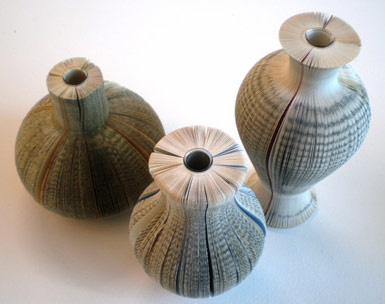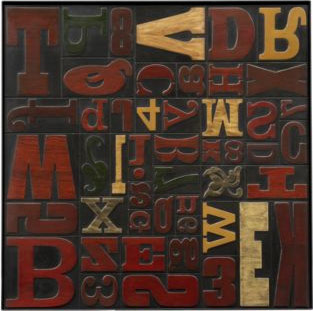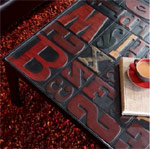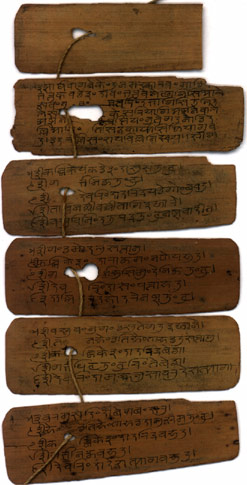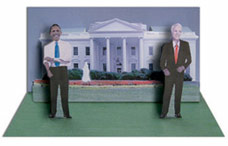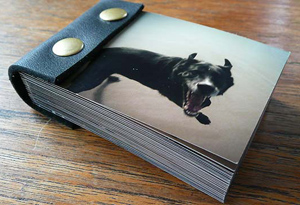When I came home all excited about my laser cut pop-up book, my husband Harold wanted to know what else I could cut. He’s done a fair amount of woodworking, so I thought I’d cut letters or symbols out of some exotic woods and make pendants and then necklaces with suede or leather cord. Should be easy — right?
 Of course nothing goes quite as planned! Harold cut the wood down and had a friend plane it to 3/16″ thick but then some of it (zebrawood) wouldn’t cut (it just burned up). Then I had to figure out how to make pendants — I haven’t made jewelry before with its new vocabulary (why are the little metal rings and bails and such called “findings”?). I found some tiny screw-in bails on-line and waited anxiously for them to arrive. Harold obligingly used his drill press to put teeny-tiny 1mm holes in the tops of the pendants. But the bails only came in silver which didn’t look right with the dark leather cord I had. Spray painting the bails black wouldn’t work, because the paint would just rub off right away. I inquired at the Tech Shop, where I’d used the laser cutter, if they had a powder coating set up (an electrostatic process that adheres power or dry paint to metal). They did, but there wasn’t a class scheduled, so in the meantime Harold found a heat-sensitive paint that fisherman use to paint patterns on their lures. I ordered the paint (and waited again for it to arrive).
Of course nothing goes quite as planned! Harold cut the wood down and had a friend plane it to 3/16″ thick but then some of it (zebrawood) wouldn’t cut (it just burned up). Then I had to figure out how to make pendants — I haven’t made jewelry before with its new vocabulary (why are the little metal rings and bails and such called “findings”?). I found some tiny screw-in bails on-line and waited anxiously for them to arrive. Harold obligingly used his drill press to put teeny-tiny 1mm holes in the tops of the pendants. But the bails only came in silver which didn’t look right with the dark leather cord I had. Spray painting the bails black wouldn’t work, because the paint would just rub off right away. I inquired at the Tech Shop, where I’d used the laser cutter, if they had a powder coating set up (an electrostatic process that adheres power or dry paint to metal). They did, but there wasn’t a class scheduled, so in the meantime Harold found a heat-sensitive paint that fisherman use to paint patterns on their lures. I ordered the paint (and waited again for it to arrive).
 To apply this paint, you heat the object with a propane torch then spray on the paint. In great anticipation I strung a few bails on a thin metal wire, heated them and sprayed. Oh no! The metal wire also got hot, and the paint adhered to the bail and the wire, fusing them together! Back to the computer to find heat-resistant (maybe Teflon?) wire. As I typed away at Google, Harold suggested I try using silver plated chain instead of leather and work on my chain-making skills (regardless of whether I used leather or silver chain, I was still going to have to attach a clasp). Certainly not rocket science, but would require some practice.
To apply this paint, you heat the object with a propane torch then spray on the paint. In great anticipation I strung a few bails on a thin metal wire, heated them and sprayed. Oh no! The metal wire also got hot, and the paint adhered to the bail and the wire, fusing them together! Back to the computer to find heat-resistant (maybe Teflon?) wire. As I typed away at Google, Harold suggested I try using silver plated chain instead of leather and work on my chain-making skills (regardless of whether I used leather or silver chain, I was still going to have to attach a clasp). Certainly not rocket science, but would require some practice.
 So that’s what I’ve done, used silver chain, leaving the powder coating lessons for another day. Below are pictures of the finished pendants. You can see more pictures by clicking on the image.
So that’s what I’ve done, used silver chain, leaving the powder coating lessons for another day. Below are pictures of the finished pendants. You can see more pictures by clicking on the image.
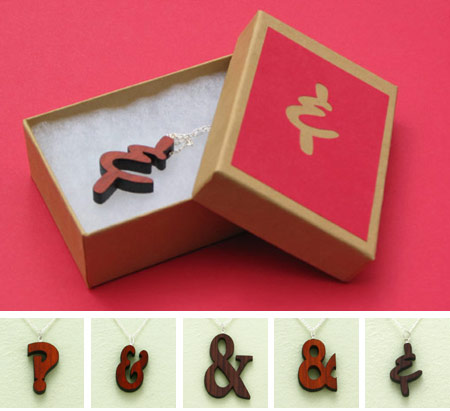
 Laura Cahill makes vases and furniture from discarded books. For the vases she wraps the spines around test tubes. She says “My idea of using second hand books came around after doing research into common unwanted objects. One of the most common unwanted objects that can be found at either charity shops, car boot sales and sometimes on the streets are books. I discovered that the glue in old books make them extremely difficult to recycle. Aware of this I challenged myself to turn the second hand books that I had been collecting, into desirable objects such as furniture, lighting and ornaments.” You can see more on Dezeen.
Laura Cahill makes vases and furniture from discarded books. For the vases she wraps the spines around test tubes. She says “My idea of using second hand books came around after doing research into common unwanted objects. One of the most common unwanted objects that can be found at either charity shops, car boot sales and sometimes on the streets are books. I discovered that the glue in old books make them extremely difficult to recycle. Aware of this I challenged myself to turn the second hand books that I had been collecting, into desirable objects such as furniture, lighting and ornaments.” You can see more on Dezeen.
